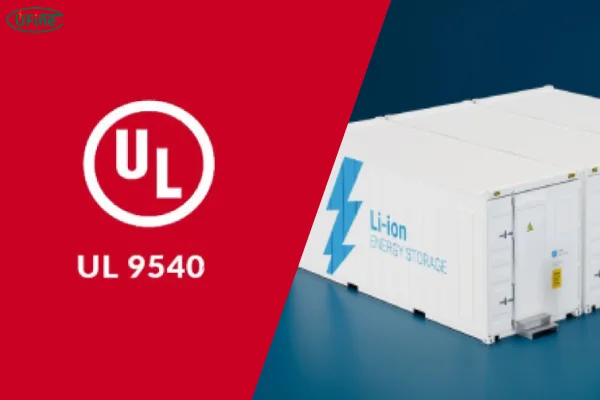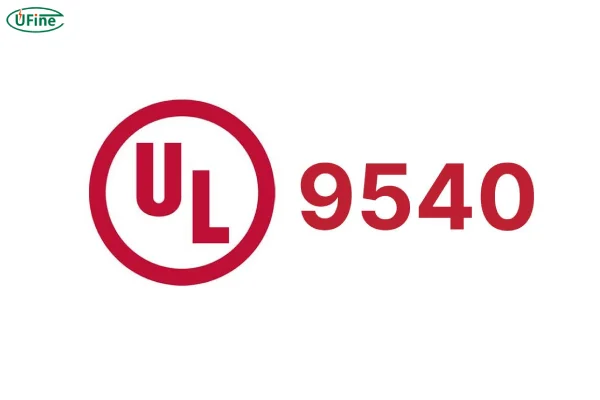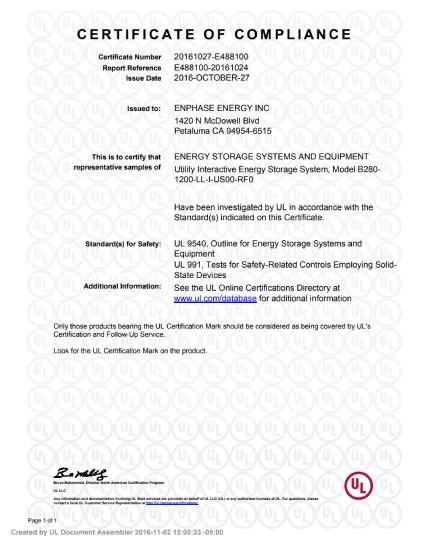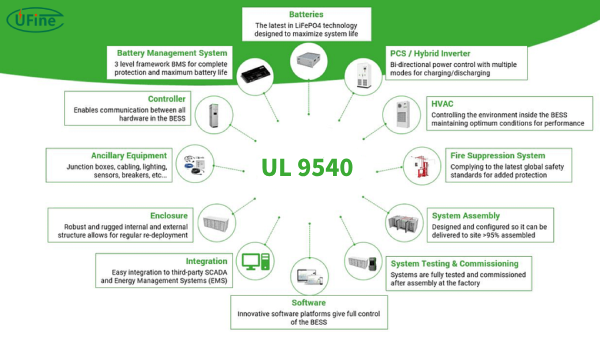If you’re involved in the energy storage industry, you’ve likely heard of UL 9540—a standard that is becoming increasingly important in ensuring the safety and reliability of energy storage systems. Whether you’re a manufacturer, installer, or end user, understanding UL 9540 is crucial. In this article, we’ll dive into what UL 9540 means, why it matters, how to get certified, and what you need to know about UL 9540A testing. Let’s break it all down in simple, easy-to-understand terms.
Part 1. What is UL 9540 listing?
UL 9540 is a safety standard developed by Underwriters Laboratories (UL) that applies to energy storage systems (ESS). The standard sets requirements for the design, construction, and performance of these systems to ensure they are safe and reliable for use in residential, commercial, and industrial applications.
When a product is UL 9540 listed, it means that the product has been tested and meets the safety standards set by UL. This includes testing for electrical safety, fire safety, mechanical safety, and more. It ensures that the energy storage system can perform as intended without posing a risk to users or the environment.
In short, UL 9540 listing verifies that an energy storage system has passed rigorous safety tests, offering peace of mind to manufacturers, installers, and consumers alike.
Part 2. What is UL 9540A testing?
UL 9540A is a test procedure specifically designed to evaluate the thermal runaway and fire safety characteristics of energy storage systems, particularly lithium-ion batteries. This testing simulates worst-case scenarios, such as battery fires or failures, to ensure that the system behaves safely in extreme conditions.
UL 9540A testing involves subjecting the energy storage system to high temperatures, overcharging, and other stress conditions to see how the system responds. It’s a comprehensive test that helps prevent fires and explosions by identifying potential safety hazards.
For manufacturers, passing UL 9540A testing is a critical step toward obtaining UL 9540 certification. It’s an extra layer of assurance that ensures the system can handle emergency situations safely.
15 FAQs About Battery Manufacturing Safety Testing
Part 3. The difference between UL 9540A and UL 9540
While UL 9540 and UL 9540A are closely related, they serve different purposes. Here’s how they differ:
-
UL 9540: This is the overall safety standard for energy storage systems, covering the performance, installation, and general safety of the system. It’s the umbrella certification that most energy storage products aim for.
-
UL 9540A: This is a specific test procedure under UL 9540, focused primarily on the thermal performance and fire safety of the system. It’s an in-depth evaluation that helps manufacturers identify any fire or explosion risks associated with their systems.
In essence, UL 9540 is the broader safety standard, while UL 9540A is a more detailed test that ensures the system is safe under extreme conditions.
Part 4. Why UL 9540 is so important for energy storage systems

UL 9540 is vital because it provides a standardized measure of safety for energy storage systems. As more and more homes, businesses, and industries rely on batteries and energy storage solutions, it’s essential to ensure that these systems are safe, reliable, and capable of handling the demands of modern energy needs.
Here’s why UL 9540 is particularly important:
- Safety Assurance: It protects users by ensuring energy storage systems meet strict safety requirements. This reduces the risk of fires, electrical failures, and other hazards.
- Consumer Confidence: A UL 9540 listed product gives consumers confidence that they are investing in a high-quality, safe energy storage solution.
- Market Access: Many countries, states, or industries require UL 9540 certification as a prerequisite for market entry. Without it, manufacturers may not be able to sell their products in certain regions.
For manufacturers, obtaining UL 9540 certification is not just a safety precaution—it’s a competitive edge in a growing market.
Part 5. The difference between UL listed and UL recognized
When it comes to UL certification, it’s important to understand the difference between UL listed and UL recognized.
-
UL Listed: This means the product has been tested and approved by UL for safety. It’s a more comprehensive certification that ensures the product meets all applicable safety standards and is safe for its intended use.
-
UL Recognized: This means that a component within a product (e.g., a specific battery or inverter) has been evaluated by UL, but the entire system has not been tested. UL Recognized is often used for components that are part of a larger system, but it doesn’t mean the whole product is UL approved.
In short, UL Listed refers to a complete product that meets all safety standards, while UL Recognized refers to components that have been evaluated but not fully certified.
Part 6. Applications of UL 9540
UL 9540 applies to a wide range of energy storage systems, from small residential solutions to large-scale industrial applications. Here are some common use cases:
-
Home Energy Storage Systems: Many homeowners are installing energy storage systems to store solar energy and reduce electricity costs. UL 9540 ensures that these systems are safe for residential use.
-
Commercial and Industrial ESS: For businesses or industries that rely on energy storage for backup power or to stabilize grid operations, UL 9540 provides the safety standards needed for large-scale installations.
-
Off-Grid Solutions: For off-grid systems, UL 9540 ensures that energy storage systems are reliable and safe when used in remote or harsh environments.
Whether you’re installing a small home battery system or managing a large-scale solar-plus-storage project, UL 9540 certification provides the safety foundation that ensures the system will perform reliably.
Part 7. Requirements for UL 9540 certification
To obtain UL 9540 certification, energy storage systems must meet specific requirements that cover various safety aspects. These include:
- Electrical Safety: Ensuring that the system does not pose any electrical hazards, such as short circuits or overloads.
- Fire Safety: Systems must be designed to resist fire hazards and include features that prevent fires from spreading.
- Mechanical Safety: The system must be physically robust and capable of withstanding environmental stresses, such as vibrations and temperature fluctuations.
- Performance Standards: The system must demonstrate reliable performance in normal operating conditions, including during charging and discharging cycles.
Manufacturers must submit their products to UL for testing and evaluation. The process can be lengthy and rigorous, but the end result is a certification that guarantees the system meets high safety standards.
Part 8. How to get UL certified?
Getting UL certified is a multi-step process that involves product testing, documentation, and ongoing compliance. Here’s how it works:
- Submit a Product for Evaluation: Manufacturers need to submit their energy storage systems to UL for testing. This includes providing detailed product specifications and design documents.
- Undergo Testing: UL will perform various tests, including electrical, mechanical, and fire safety tests, to ensure the product meets the UL 9540 standard.
- Certification Decision: If the product passes the tests, UL will issue a UL Listing for the product. This means the product is certified for sale and use.
- Ongoing Compliance: Once certified, the manufacturer must continue to meet UL’s ongoing requirements. This may include periodic inspections or additional testing as needed.
The process can be time-consuming, but UL certification helps to ensure that the product is safe, reliable, and ready for the market.
Part 9. What you should know after getting approved?
Once your product has been approved for UL 9540, there are a few things to keep in mind:
- Ongoing Compliance: As mentioned, you’ll need to maintain your certification by following UL’s requirements and undergoing regular inspections.
- Product Labeling: Once certified, your product can be labeled with the UL Mark, indicating it has passed UL’s rigorous safety tests. This label is a sign of quality that helps build trust with consumers.
- Market Advantage: UL 9540 certification can give your energy storage system a competitive edge in the market. It signals that your product meets the highest safety standards, which is a key selling point for consumers.
Being UL-certified is an achievement, but it comes with the responsibility of maintaining those standards and ensuring that your products continue to meet safety regulations.
Part 10. Conclusion
In the growing world of energy storage systems, UL 9540 certification is a critical factor in ensuring safety, reliability, and consumer trust. Whether you’re looking to certify your product or simply trying to understand why UL 9540 matters, knowing the ins and outs of this standard will give you a better understanding of the safety measures that protect both users and manufacturers alike.
By ensuring that your energy storage system meets UL 9540 requirements, you can confidently market your product, knowing it has passed the most stringent safety tests. So, if you’re in the energy storage business, getting UL 9540 certified is not just an option—it’s a necessity.
Related Tags:
More Articles

Paper Battery vs. Flexible Battery: What’s the Difference and Which Is Better?
Paper vs. flexible batteries: learn the key differences, benefits, and which power source fits best for wearables, sensors, and smart tech.
What to Know Before Buying a Tiny LiPo Battery for Your Project
Tiny LiPo batteries are powerful and compact. Learn how to choose the right one for your project with specs, safety, and charging tips.
Bloated LiPo Battery: Will It Explode?
Will a bloated LiPo battery explode? Discover the causes, risks, safety steps, and expert tips to avoid disaster and protect your gear. Must-read safety guide!
12V 100Ah Lithium Ion Battery Price: Full Guide
Learn about 12V 100Ah lithium-ion battery price, from cost ranges to best brands, hidden fees, and how to get the best deal. A must-read for smart buyers!
Resistance and Conductivity: What It Means for Your Lithium Batteries
Resistance and conductivity impact lithium battery performance, lifespan, and safety—learn how they work and why they matter.






